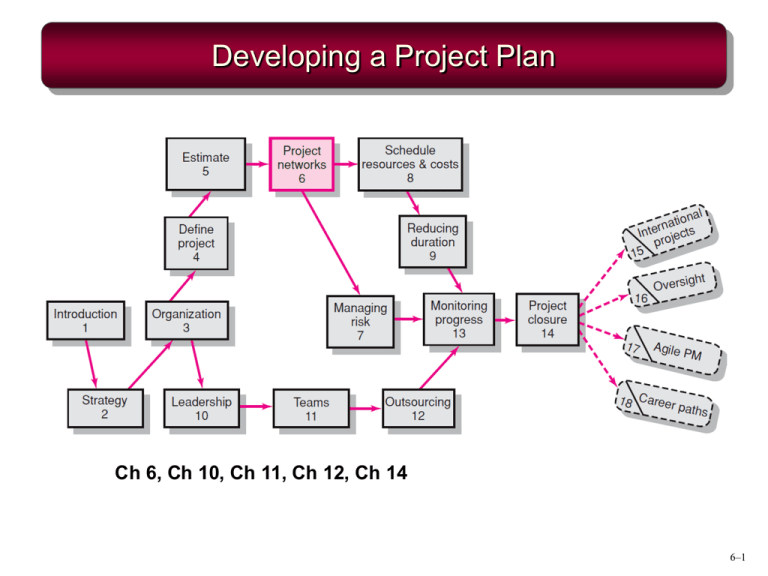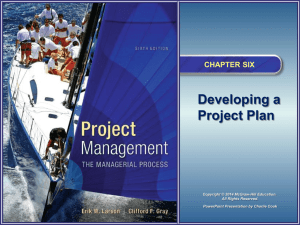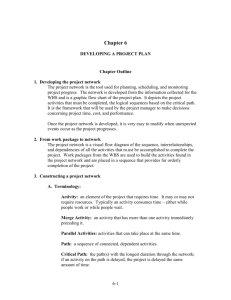0 Chapter 6 – Developing a Project Plan
advertisement

Developing a Project Plan Ch 6, Ch 10, Ch 11, Ch 12, Ch 14 6–1 Developing the Project Plan • The Project Network –A flow chart that graphically depicts the sequence, interdependencies, and start and finish times of the project job plan of activities that is the critical path through the network. • Provides the basis for scheduling labor and equipment. • Enhances communication among project participants. • Provides an estimate of the project’s duration. • Provides a basis for budgeting cash flow. • Identifies activities that are critical. • Highlights activities that are “critical” and can not be delayed. • Help managers get and stay on plan. 6–2 Developing the Project Plan • The project network is the tool used for planning, scheduling, and monitoring project progress. • The network is the framework for the project information system that will be used by the project managers to make decisions concerning project time, cost, and performance. • Once the network is developed, it is very easy to modify or change when unexpected events occur as the project progresses. • The network is developed from the information collected for the WBS and is a graphic flow chart of the project job plan. • Work packages from the WBS are used to build the activities found in the project network. 6–3 From WBS/Work Packages to Network • An activity can include one or more work packages. • The activities are placed in a sequence that provides for orderly completion of the project. • Networks are built using nodes (boxes) and arrows (lines). • The node depicts an activity, and the arrow shows dependency and project flow. B A • Networks provide the project schedule by identifying dependencies, sequencing, and timing of activities, which the WBS is not designed to do. • The primary inputs for developing a project network plan are work packages. 6–4 Integration of WBS and OBS FIGURE 4.5 4–5 WBS/Work Packages to Network FIGURE 6.1 6–6 WBS/Work Packages to Network • The lowest level deliverable in Figure 6.1 is “circuit board.” • The cost accounts (design, production, test, software) denote project work, organization unit responsible, and time phased budgets for the work packages. • Each cost account represents one or more work packages. • For example, the design cost account has two work packages (D-1-1 and D-1-2)—specifications and documentation. • The software and production accounts also have two work packages. • Developing a network requires sequencing tasks from all work packages that have measurable work. 6–7 WBS/Work Package to Network (cont’d) FIGURE 6.1 (cont’d) 6–8 Constructing a Project Network • Terminology –Activity: an element of the project that requires time. A –Merge Activity: an activity that has two or more preceding activities on which it depends. B –Parallel (Concurrent) Activities: Activities that can occur independently and, if desired, not at the same time. D C 6–9 Constructing a Project Network (cont’d) • Terminology –Path: a sequence of connected, dependent activities. –Critical path: the longest path through the activity network that allows for the completion of all projectrelated activities; the shortest expected time in which the entire project can be completed. Delays on the critical path will delay completion of the entire project. C A B D (Assumes that minimum of A + B > minimum of C in length of times to complete activities.) 6–10 Constructing a Project Network (cont’d) • Terminology –Event: a point in time when an activity is started or completed. It does not consume time. –Burst Activity: an activity that has more than one activity immediately following it (more than one dependency arrow flowing from it). • Two Approaches B –Activity-on-Node (AON) • Uses a node to depict an activity. A C –Activity-on-Arrow (AOA) • Uses an arrow to depict an activity. D 6–11 Basic Rules to Follow in Developing Project Networks 1. Networks typically flow from left to right. 2. An activity cannot begin until all preceding connected activities are complete. 3. Arrows indicate precedence and flow and can cross over each other. 4. Each activity must have a unique identifying number that is greater than any of its predecessor activities. 5. Looping is not allowed. 6. Conditional statements are not allowed. 7. Use common start and stop nodes. 6–12 Activity-on-Node (AON) - Fundamentals • An activity is represented by a node (box). • The dependencies among activities are depicted by arrows between the (boxes) on the AON network. • The arrows indicate how the activities are related and the sequence in which things must be accomplished. • The letters in the boxes serve to identify the activities. In practice, activities have identification numbers and descriptions. • The relationships can be found by answering three questions for each activity: – Which activities must be completed immediately before this activity? These activities are called predecessor activities. – Which activities must immediately follow this activity? These activities are called successor activities. – Which activities can occur while this activity is taking place? This is known as a concurrent or parallel relationship. 6–13 Activity-on-Node Fundamentals FIGURE 6.2 6–14 Activity-on-Node Fundamentals (cont’d) FIGURE 6.2 (cont’d) 6–15 Network Information TABLE 6.1 6–16 Koll Business Center—Partial Network FIGURE 6.3 6–17 Koll Business Center—Complete Network FIGURE 6.4 6–18 Benefits of Graphical Networks • It shows a graphical map of the project activities with sequences and dependencies. • The addition of time to the network allows us to: – estimate how long the project will take. – When activities can or must start. – when resources must be available – which activities can be delayed – when the project is estimated to be complete. – necessitates early assessment of resource needs in terms of material, equipment, and people. • In essence the project network with activity time estimates links planning, scheduling, and controlling of projects. 6–19 Network Computation Process • Forward Pass—Earliest Times –How soon can the activity start? (early start—ES) –How soon can the activity finish? (early finish—EF) –How soon can the project finish? (expected time—ET) • Backward Pass—Latest Times –How late can the activity start? (late start—LS) –How late can the activity finish? (late finish—LF) –Which activities represent the critical path? –How long can activity be delayed? (slack or float—SL) 6–20 Network Information TABLE 6.2 6–21 Activity-on-Node Network FIGURE 6.5 6–22 Activity-on-Node Network Forward Pass (ES + DUR = EF) FIGURE 6.6 6–23 Forward Pass Computation • Add activity times along each path in the network (ES + Duration = EF). • Carry the early finish (EF) to the next activity where it becomes its early start (ES) unless… • The next succeeding activity is a merge activity, in which case the largest EF of all preceding activities is selected. • Stated differently, the forward pass assumes every activity will start the instant in time when the last of its predecessors is finished 6–24 Backward Pass Computation • The backward pass starts with the last project activity(ies) on the network. You trace backward on each path subtracting activity times to find the late start (LS) and finish times (LF) for each activity. • Subtract activity times along each path in the network (LF - Duration = LS). • Carry the late start (LS) to the next activity where it becomes its late finish (LF) unless • The next succeeding activity is a burst activity, in which case the smallest LF of all preceding activities is selected. 6–25 Activity-on-Node Network Backward Pass (LF - DUR = LS) FIGURE 6.7 6–26 Determining Slack – Is the amount of time an activity can be delayed after the start of a longer parallel activity or activities. – Is how long an activity can exceed its early finish date without affecting early start dates of any successor(s). – Allows flexibility in scheduling scarce resources. – If slack of one activity in a path is used, the ES for all activities that follow in the chain will be delayed and their slack reduced. – Use of total slack must be coordinated with all participants in the activities that follow in the chain. – After slack for each activity is computed, the critical path(s) is (are) easily identified. When the LF = EF for the end project activity, the critical path can be identified as those activities that also have LF = EF or a slack of zero. – The critical path is the network path(s) that has (have) the least slack in common. 6–27 Sensitivity – The likelihood the original critical path(s) will change once the project is initiated. – The critical path is the network path(s) that has (have) the least slack in common. – Sensitivity is a function of the number of critical or nearcritical paths. – A sensitive network would be one or more than critical paths and/or noncritical activities with very little slack. – Under these circumstances the original critical path is much more likely to change once work gets under way on the project. – Project managers assess the sensitivity of their network schedules to determine how much attention they should devote to managing the critical path. 6–28 Activity-on-Node Network with Slack (LS - ES = SL) or (LF - EF = SL) FIGURE 6.8 6–29 Practical Considerations –Conditional statements such as “if test successful build proto, if failure redesign” are not permitted. –Looping is not allowed . It is an attempt by the planner to return to an earlier activity. –Each activity needs a unique identification code—usually a number. –Laddering: Activities are broken into segments so the following activity can begin sooner and not delay the work. 6–30




